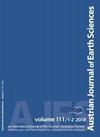纳米比亚西北部奥塔维群Marinoan雪球地球冰后过渡层的微生物活动记录
IF 1.1
4区 地球科学
Q2 Earth and Planetary Sciences
引用次数: 13
摘要
本文研究了马里诺世雪球地球冰期冰后层微生物席的形成。对纳米比亚西北部(新元古代)奥塔维群Ghaub - Maieberg组(Keilberg段开始)过渡层进行了高分辨率调查。进行了宏观表征、岩石光学显微镜、XRD矿物学、拉曼光谱等研究,并收集了地球化学(主微量元素含量)和碳酸盐碳同位素数据。确定了三种类型的微生物贡献:(1)原生、同沉积富铁生物;(2)含铁矿物(黄铁矿、绿泥石)生物降解次生生物;(3)包覆在碎屑上的伪二级结构。这些由铁氧化细菌组成的微生物群消耗来自不同来源的铁,如热液溶液或含铁矿物。根据铁生物形态、矿物学和地球化学特征,我们认为研究区域的马里诺冰川后过渡层(Ghaub-Maieberg边界)形成于中性、亚氧条件下的咸淡水中。____________________________________________________________________________________ 奥地利地球科学杂志卷110/1维也纳2017微生物活动记录Marinoan雪球地球冰河期过渡层连接杂岩和碳酸帽(NW-Namibia Otavi集团 )__________________________________________ 1) 2) 2) 3) *) 4) 4) 5) 1) 6) Ildiko GYOLLAI, Marta POLGARI Krisztian FINTOR elem PAL-MOLNAR,1)维也纳大学岩石圈研究系,奥地利维也纳Althanstrasse 14, A-1090;2)匈牙利科学院地质和地球化学研究所地球生物成矿和天体生物学研究组天文和地球科学研究中心,布达佩斯1112,Budaörsi str. 45,匈牙利;3) Eszterházy Károly匈牙利大学自然地理与地理信息学系,Leányka第6区,3300埃格尔;4)塞格德大学矿物学、地球化学和岩石学系,匈牙利塞格德6702;5)维也纳大学地球动力学与沉积学系,奥地利维也纳Althanstrasse 14, A-1090;6)维也纳自然历史博物馆,奥地利维也纳Burgring 7 A-1010;*)通讯作者,rodokrozit@gmail.com雪球地球;冰川的消失;微生物垫;iron-oxidizing细菌;生物降解;帽碳酸盐岩;Otavi组;NW-Namibia本文章由计算机程序翻译,如有差异,请以英文原文为准。
Microbial activity records in Marinoan Snowball Earth postglacial transition layers connecting diamictite with cap carbonate (Otavi Group, NW-Namibia)
This study concerns the microbial mat formation in postglacial layers of the Marinoan Snowball Earth glaciation. A high resolution investigation was carried out on the transition layers of Ghaub to Maieberg Formation (start of Keilberg Member) of the Otavi Group in NW-Namibia (Neoproterozoic). Macroscopic characterization, optical rock microscopy, XRD mineralogy, Raman spectroscopy investigations were done and geochemical (major and trace element content) as well as carbonate carbon isotopic data were collected. Three types of microbial contributions were determined: (1) primary, synsedimentary Fe-rich biomats; (2) secondary biomats from biodegradation of Fe-bearing minerals (pyrite, chlorite); and (3) pseudo-secondary structures coating on clasts. These microbial mats of iron-oxidizing bacteria consumed iron from different sources, such as hydrothermal solutions or ironbearing minerals. On the basis of the morphology of Fe-biomats, and the mineralogical and geochemical signatures, we suggest that the Marinoan postglacial transition layers (Ghaub-Maieberg boundary) formed under neutral, suboxic conditions in brackish water at the studied locality.____________________________________________________________________________________ Austrian Journal of Earth Sciences Volume 110/1 Vienna 2017 Microbial activity records in Marinoan Snowball Earth postglacial transition layers connecting diamictite with cap carbonate (Otavi Group, NW-Namibia)__________________________________________ 1)2) 2)3)*) 4) 4) 5) 1)6) Ildikó GYOLLAI , Márta POLGÁRI , Krisztián FINTOR , Elemér PÁL-MOLNÁR , Friedrich POPP & Christian KOEBERL 1) Department of Lithospheric Research, University of Vienna, Althanstrasse 14, A-1090 Vienna, Austria; 2) Research Center for Astronomy and Geosciences, Geobiomineralization and Astrobiological Research Group, Institute for Geology and 2) Geochemistry, Hungarian Academy of Sciences, 1112 Budapest, Budaörsi str. 45, Hungary; 3) Eszterházy Károly University, Dept. of Physical Geography and Geoinformatics, Leányka str. 6, 3300 Eger, Hungary; 4) Szeged University, Department of Mineralogy, Geochemistry and Petrology, Egyetem str. 2-6, 6702 Szeged, Hungary; 5) Department of Geodynamics and Sedimentology, University of Vienna, Althanstrasse 14, A-1090 Vienna, Austria; 6) Natural History Museum, Vienna, A-1010 Burgring 7, Vienna, Austria; *) Corresponding author, rodokrozit@gmail.com Snowball Earth; deglaciation; microbial mats; iron-oxidizing bacteria; biodegradation; cap carbonate; Otavi Group; NW-Namibia
求助全文
通过发布文献求助,成功后即可免费获取论文全文。
去求助
来源期刊

Austrian Journal of Earth Sciences
Earth and Planetary Sciences-Paleontology
CiteScore
3.10
自引率
0.00%
发文量
0
审稿时长
>12 weeks
期刊介绍:
AUSTRIAN JOURNAL OF EARTH SCIENCES is the official journal of the Austrian Geological, Mineralogical and Palaeontological Societies, hosted by a country that is famous for its spectacular mountains that are the birthplace for many geological and mineralogical concepts in modern Earth science.
AUSTRIAN JOURNAL OF EARTH SCIENCE focuses on all aspects relevant to the geosciences of the Alps, Bohemian Massif and surrounding areas. Contributions on other regions are welcome if they embed their findings into a conceptual framework that relates the contribution to Alpine-type orogens and Alpine regions in general, and are thus relevant to an international audience. Contributions are subject to peer review and editorial control according to SCI guidelines to ensure that the required standard of scientific excellence is maintained.
 求助内容:
求助内容: 应助结果提醒方式:
应助结果提醒方式:


